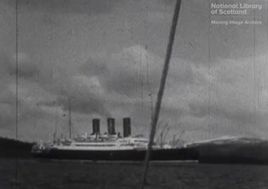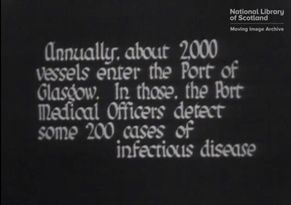Seminar: Port Health Authority 1928 [1745]
Published: 11 October 2018
October 2018
At the beginning of the nineteenth century industrialization came into effect, allowing for an expansion of the global market at a far more efficient pace. Iron-hulled ships began to replace wooden structures and engineers decided to utilize the River Clyde in Glasgow to allow the city’s commerce and heavy goods industry to truly flourish. The River Clyde was always at the heart of Glasgow’s trade, however alongside advancements in technology came the realization that Glasgow could gain recognition as an industrial city on a larger scale. Evidence of pre-historic trading via fishing communities exists along the Clyde with ‘Stone Age canoes having been unearthed along the banks of the river’. These Stone Age canoes currently reside at the Riverside Transport Museum in Partick and are on display alongside an informative video on the fragile restoration process of the canoes. Later it is thought that Celtic Druids traded with the Romans who travelled to and from Glasgow using the Clyde. This firmly cements the River Clyde as a crucial tool for survival at the heart of Glasgow since the beginning of time. To accommodate for larger vessels during the tea and tobacco trading years, banks and depths of the Clyde were deepened by engineers which played a crucial role in Glasgow being recognized as the ‘Second City of the Empire’. Main shipbuilding locations in Glasgow include Dumbarton, Clydebank and Greenock. Clipper ship ‘Cutty Sark’ was built on the River Clyde in 1869 for the Jock Wills Shipping Line. The clipper was crafted specially for the tea trade, an intensely competitive race across the globe from China to London. It was one of the last tea clippers to be built on the Clyde and has since come to be recognized as one of the fastest. This effectively demonstrates the extent of Glasgow’s influence in the prosperous global market.
By 1900, Glasgow was a wealthy industrial city with a highly skilled manufacturing workforce and a growing reputation for original craft and design. Despite Glasgow’s firm place within the trading of foreign goods, the opening of the global market brought some concerns. The video titled Port Health Authority dated 1928 in the Kelvinhall Moving Image Archive displays the threat globalization and the international market posed to the health and safety of Glasgow and the United Kingdom more widely. The role of the Port Health Authority in Glasgow during the 1920s was to, ‘Supervise incoming foreign shipping— to guard against the ever-present danger of infectious disease— to examine food cargoes, eliminating what is unfit for human consumption— and to control the sanitary conditions on board ship in the docks— THESE are the duties of a Port Health Authority’. Utilising the moving image archive allows historians to develop an understanding of globalization in action as it takes place in the context of its historical timeframe.

The video demonstrates Glaswegian workers interacting with a trading ship arriving in the docks of Glasgow carrying goods from all over the world. The ship itself has been identified as the SS Cameronia built in 1920 at Port Glasgow. Shots in the moving image footage included granary and grain being loaded onto a lorry to be transported across the UK. There is also footage of jaffa oranges being supervised and inspected intensely to reduce the risk of disease. Dead rats found on the ships would then be dissected by bacteriologists for signs of plague. Should the bodies of rats carry evidence of disease and infection, the ship would be gassed with cyanide. This process can also be seen in the moving image archive footage. The video is evidence of Glasgow’s shipbuilding environment and testifies to the amount of jobs this industry created for the city itself. The footage also demonstrates the various modes of globalization through the international movement of food, animals and also groups of people.
Whilst Glasgow’s shipbuilding industry is widely known and recognized as the founding basis of the city’s industrial identity, the video in discussion conveys the role of the Port Health Authority workers which demonstrates the threats associated with extending global links. To this day the Glasgow Port Health Authority is active, assessing goods which are begin prepared to trade within the UK.
Note: The Kelvinhall Moving Image Archive is located on Argyle Street just a 3 minute walk from the entrance of Kelvingrove. Access is free and a huge range of materials are available to explore through the National Library Scotland database.
Things to Consider:
- Traces of globalization can be found from even the earliest of historical objects, however it is still very much a topic in the present day. Does globalization and the international market of commodities pose any threats in today’s society the way they may have in 1928?
- Aside from the physical journeys and exchanging of goods, what other forms of global links can be uncovered from the Kelvinhall moving archive footage? Consider relations between people themselves, commodities which circulated the trading markets etc.
First published: 11 October 2018
Sources:
- Historic Glasgow: People Make Glasgow [Accessed 8 June 2018]
- Clyde Waterfront: Shipbuilding on the Clyde [Accessed 7 June 2018]

